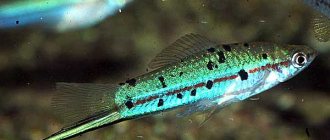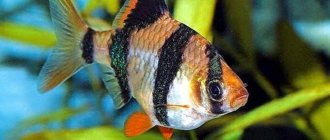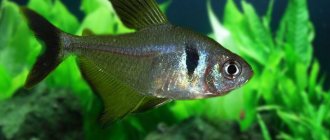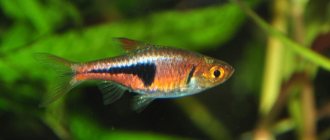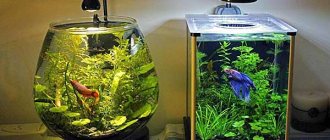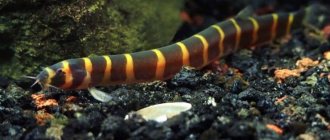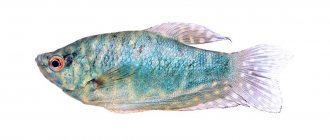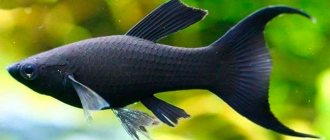When breeding swordtails at home, you need to follow some rules. These fish are viviparous, and the hatched fry are immediately exposed to danger from other inhabitants of the aquarium. Therefore, before the appearance of offspring, the pregnant female must be separated in order to protect the babies from their relatives. The nuances of feeding parents and young animals also deserve attention. We will talk about all this in an article devoted to breeding these fish.
Females change sex
These fish are recommended even for beginner aquarists. They adapt well to their environment. They reproduce easily. Given suitable living conditions, most fry survive.
If the owner provides the fish with abundant and varied food, which includes 70% live food and 30% dry food, then they can give birth monthly. And they are always ready to mate. If you feed swordtails only dry food, they will most likely become infertile. Dry food can be given, but only as complementary food or temporarily.
It is required that the water in the aquarium be maintained at 26-27 degrees. This is the optimal temperature for a comfortable life for pets. Constant aeration in the aquarium will help mating games.
During everyday life, sometimes strange, at first glance, events occur - female swordtails change sex. They become thick, a small sword grows on the tail and a gonopodium appears. Such a female will no longer produce offspring. It is necessary to monitor such individuals.
Diet of swordtails
Unpretentiousness in nutrition is one of the positive traits characteristic of this undemanding fish. In everyday feeding, it is possible to use both plant foods and food of animal origin. Most often, the menu for fish is compiled randomly. The main task of the aquarist is not to overfeed pets and maintain a sense of proportion when using dry mixtures in the diet. It is recommended to maintain proportions - animal food in relation to plant food should be 1 to 2. Thus, plant food should prevail over animal food.
Live food offered at poultry markets is ideal as animal food. These include living hydrobionts, such as bloodworms, coretra, tubifex and a variety of frozen crustaceans packaged in briquettes. From plant foods, scalded nettle leaves, beet tops and steamed pumpkin and zucchini pulp are perfect. All these food delights can provide pets with a rich diet of tasty vitamin nutrition. Such an excellent menu will not leave indifferent any aquatic inhabitant in an aquarium tank and is capable of providing maximum nutrients to regulate the body’s nutritional needs.
Adding a few drops of fish oil or a small handful of dry spirulina to the feed composition will saturate the fish food with the polyunsaturated fatty acids necessary for procreation, which the body of tropical fish desperately needs,
Vitamins Omega-3 and Omega-6 will have a beneficial effect on the body of adults preparing to produce juvenile spawners.
Sex differences and signs of pregnancy
Before mating begins, the owner must count how many males and females are swimming in his aquarium. Determined by external signs. Let's say right away that this is not a color. Both partners are the same.
But the male has a long, sword-shaped tail. The size of a male individual in its natural environment is up to 12 cm (the “sword” is not taken into account), the body shape is narrow and elongated. Aquarium fish are half the size. At the end of the abdomen is an elongated fin (gonopodium). It goes like a tube. Through him, the male fertilizes the female. The “boys” are nimble and aggressive towards each other. If there are more of them in the reservoir, they will fight, which the owner will notice.
The female has no “sword” on her tail or looks very small. The body is round, up to 10 cm in size (for those living in a pond), 4-5 cm (for aquarium specimens).
We recommend reading
Astronotuses: care and maintenance
Conditions for keeping swordtails
After the discovery of this species, it was given the Latin name Xiphophorus Helleri, which translates as green, changeable swordtail, which very accurately reflects the coloring features of this fish caught in the wild reservoirs of Latin America.
Only green swordtails are found in nature, and all other color variants are bred through painstaking selection between wild swordtail and carefully selected color varieties of calico platies. Now among these viviparous carp-toothed fish you can find fish of any color. These can be pets with red, yellow, orange, black, marbled and scarlet colors. The painstaking work of breeders has been repeatedly justified by the appearance of new breeds of swordtails in the aquarium industry.
Keeping swordtails at home requires that for the life of pets it is necessary to use a wide, flat container with a height of at least 20 cm and a volume of at least 50 liters. Such aquarium parameters should create comfortable living conditions for pets. And using a tight lid or top glass that fits the container will prevent active fish from jumping out of an uncovered aquarium.
Regarding the water parameters preferred for existence in the artificial conditions of a home pond, for viviparous carp-toothed it is desirable to observe the following parameters: the water temperature should not be subject to sudden changes and should be between 22 and 26 degrees Celsius.
At the same time, to prevent viral diseases in the water, it is necessary to add 1 tablespoon of table salt per 10 liters of fresh aquarium water and maintain the water hardness within the DH range of 10-22 degrees, and maintain a pH of 7-9. The character of the fish is quite peaceful, and the occurrence of short-term skirmishes in males is extremely rare and only when they are in a comfortable state. If there are a small number of them in a marriage and there is a shortage of male population. To reduce the likelihood of conflicts in a group of fish, it is necessary to increase the number of adult males to the optimal number. Their number should not be less than three. Tropical fish of the carp-tooth family are disgusting at oxygen deprivation, and therefore the first priority to ensure stable conditions in an aquarium farm will be to install an aerator to ensure the saturation of the water with oxygen.
Mating and causes of infertility
If the fish grew up together, or the owner took them as adults, but they swim together for some time, they will mate freely. Otherwise, you need to give them time to get to know each other. For fish this takes a little time. Age for mating is 6-8 months.
The fertilization process occurs through the gonopodium, the male reproductive organ. With the help of this tube, the fish communicate, and milk enters the female’s genital tract. They look like capsules containing sperm. After about 10-15 minutes, they disintegrate, releasing sperm, which fertilize the eggs in the abdomen of the female.
And soon the owner will notice that the females have rounded tummies, and they swim more slowly. A pregnant individual has a black spot under its tail. If the belly becomes full, it is 100% that the fish is pregnant.
With good nutrition, they reproduce every month. And if you feed them only dry food, they will not reproduce. Also, the absence of offspring indicates poor living conditions. For example, overpopulation of an aquarium with a large number of inhabitants. Another reason is sex change by females. In this case, only males end up in the aquarium.
Reproduction and breeding of swordtails
Reproduction and breeding of swordtails
Swordtails (Xiphophorus helleri) belong to the family of poeciliid fish. Xiphophorus helleri is translated from Greek as “xiphos” - sword, “phoros” - to carry. The prefix “Helleri” was assigned to swordtails after the German naturalist Karl Bartholomeus Heller, who first caught these fish in Mexican lakes and safely transported them to Europe.
Breeding and propagating swordtails is absolutely not a difficult task . It is similar to the reproduction of guppies and other livebearers. We can say that the reproduction of swordtails actually occurs independently.
Sexual maturity in swordtails occurs at the age of 5-6 months. For breeding (and for their own comfort), it is recommended to keep fish in a ratio of one male to three females. In the process of courting a female, the male performs a kind of courtship dance - shuttle movements back and forth.
Fertilization of mature eggs occurs inside the female. This process may take several days. An interesting feature is that a once fertilized female swordtail can give birth to offspring several more times, even in the absence of a male.
The gestation period of a female swordtail is 4-6 weeks. This period depends on the parameters of the aquarium water, temperature, lighting and feeding.
The pregnant female has a full abdomen and a "black pregnancy spot" under her tail. It is believed that a few hours before giving birth, the female’s belly becomes square, the female begins to move more actively, rushing up and down along the aquarium glass.
pregnant female swordtail
Before giving birth, the female's belly becomes large and a black spot appears near the anal fin.
At one time, the female swordtail spawns from 15 to 100 or more fry. Spawning usually occurs in the morning. With plenty of nutrition and a water temperature of 26-27° C, birth can occur monthly. The key to good breeding and reproduction of swordtails is the absence of nitrogen compounds in the home aquarium.
Preparing for childbirth
Typically, spawning refers to the process of mating and fertilization of eggs by the male. But female swordtails give birth to babies alive. Babies develop in utero. For the birth to be successful, the owner must take the following actions.
- Feed the fish with daphnia and bloodworms.
- There is no need to increase the water temperature.
- Add vegetation to the aquarium, but it is important not to overdo it. Where there is a lot of greenery, the water tends to stagnate and needs to be changed more often. Plants increase the temperature in the aquarium and reduce the amount of oxygen, which is harmful for pets.
- Prepare a place for the female to be deposited (save the water, pour it into a three-liter jar, throw 2 branches of algae into it). Cover the container with a nylon lid with holes or a gauze bandage. So, air will pass there, but the fish will not jump out.
The female carries the babies for 4 to 6 weeks. Whether it will take less time to bear the babies or more depends on the temperature in the aquarium, feeding, and how much light the house will have. The better the living conditions in the water house, the sooner the female will give birth to babies. They will be viable and nimble.
How to create optimal conditions for reproduction?
Swordtails are viviparous fish that produce fry ready for a full life. They become sexually mature at the age of 6-8 months, some specimens may be ready to breed at the age of 3 months. To ensure successful reproduction, you need to pay special attention to the diet of future breeders. Protein food will allow you to produce as many healthy fry as possible.
The optimal food supply for adult males and females is live and plant food. A few weeks before breeding, feed the fish with daphnia, cyclops, coretra, brine shrimp and bloodworms. From plant food, food with spirulina, spinach and lettuce leaves, dandelion leaves, soft cereals (rice, millet, oatmeal without salt) are suitable. You should not oversaturate the aquarium with food containing algae, so that the water does not become enriched with ammonia and nitrates.
See how to properly breed swordtails.
Reproduction can be stimulated by changing the water, as well as increasing its temperature by several degrees. Provide filtration in the aquarium using an internal filter and aeration. Clean water saturated with oxygen will stimulate mating games of fish. Once a week, replace 25% of the water with fresh and clean water.
Swordtails, whose reproduction will occur not in a spawning tank, but in a community aquarium, must get used to a gradual increase in water temperature. The temperature should be set at 26-28 o C, increasing it over 5-7 days. The acidity of aquarium water is allowed at 7.0-8.0 pH, hardness - 10-12 dH. The number of females and males in the brood depends on the water temperature. In water with a temperature below 24 degrees there will be more females, above 25-25 degrees - males. Similar water parameters should be present in the spawning tank. To prevent producers from experiencing shock when moving into such a tank, the permanent aquarium and the spawning aquarium must have the same environmental parameters.
Preparing fish and spawning grounds for reproduction
In order for the offspring to turn out beautiful and healthy, you should select the right males and females for spawning. Males should be 8 months old, their caudal fin should be distinguished by a long lower ray, and their gonopodium should increase in size. The female should be 8-10 months old, large in size and have a rounded abdomen, which indicates readiness to reproduce.
Fertilization of the swordtail fish is intrauterine. If fertilization has occurred, some of the male’s sperm will remain in the female’s abdominal cavity, which will fertilize the female again, without the participation of a male. Therefore, if you get yourself a swordtail, you should know that these fish can produce offspring every month. During one spawning, the female swordtail will give birth to 50-200 fry.
Why exactly this amount? The fact is that young females bring fewer offspring, mature ones - more, and with each birth the number of fry will increase. Also, the number of babies depends on the species and conditions of keeping the fish. Pregnancy lasts 4-6 weeks, the female’s abdomen will become round, and before giving birth it will become almost square in shape. A month before birth, you need to prepare a spawning tank.
A container of 25-50 liters with infused tap water is suitable as a spawning tank. It is recommended to plant small-leaved vegetation at the bottom of the tank, in which the fry will hide. After preparing the spawning area, a female is released into it and fed with live food. After the birth of the babies, the female fish is placed in a common aquarium so that she does not eat her brood. To delicately catch a female, use a net.
Watch how the swordtail fry are born.
Can swordtails change their gender?
Swordtails are special viviparous fish that are capable of changing sex throughout their lives. This feature is due to the absence of sex chromosomes. Newborn swordtails do not have obvious sexual characteristics; they will be noticeable only at the age of 3-6 months. Some fry reproduce at the age of 3-4 months, so they should be sorted by gender - females and males should be placed in separate containers.
During life, a female swordtail can become a male, and vice versa. Such metamorphoses are characteristic of those individuals who try to preserve the species in the face of the threat of extinction of the flock. One aquarium can contain 1 male and 2-3 females. As time passes, the male may die, and one of the females will begin to turn into a male. A gonopodium forms and the lower ray of the caudal fin lengthens. When fish that have changed sex from female to male reproduce, their offspring will be female.
You can adjust the sex of the fry of future pets. If you want to breed males or females for sale, the water temperature must be increased or decreased a few degrees. Avoid early breeding of fry, they are ready for this at an early age. When crossing species, beautiful offspring can be obtained; when crossing selected breeds, degeneration will occur.
We deliver babies
Before giving birth, the female must be caught with a net and transplanted into a prepared container. 2 hours before the onset of labor, the owner will notice that the fish’s belly becomes square. The female feels anxious and swims quickly, diving first up and then down, and walks along the glass of the aquarium. This means that labor will begin soon.
We recommend reading
Maintenance and care of speckled catfish
As a result, the mother gives birth to the babies, and they immediately begin to swim in a jar or other container. At one time, from 40 to 200 small fish are born. At this point, the reproduction seems to be over, but there is still a lot of work ahead.
The female who has given birth must be caught with a net and sent back to the general aquarium. After all, she can eat babies too. It's better not to take risks. The fact that babies are born alive and fully formed is very good. They will eat suitable food from the first days of life.
Newborn swordtails are fully formed and bright. If the owner wants to plant the offspring from a three-liter jar in a small house, he can easily collect them by lifting them up with a net with small cells. At home, fry are best obtained in the spring, when there is a lot of live food.
Birth of fry
You can understand that labor is beginning by the individual’s thrashing around the aquarium. Her stomach becomes square. Most often, swordtails give birth in the morning. The number of fry born at one time can reach up to 200 pieces. Newborn fish should be left in a container with their mother.
One female swordtail can bring up to 200 fry at a time
Reproduction of swordtails in an aquarium can occur constantly. To do this, the water temperature should not fall below 26 degrees. If the owner cannot place the pregnant female in a separate container or compartment, dense bushes in the aquarium will be required. They are needed so that the woman in labor can hide there at the most crucial moment. Male fry born in an aquarium should not remain there forever. As soon as they reach sexual maturity, they need to be removed.
About the rules of feeding fry
From birth and within 14 days, fry will eat 150 and even 170% more food than their own weight. From the age of 1 month they need feed from 80 to 100% of their live weight. When babies turn two months old, they will need only 30% of their weight in food. After puberty, the norm is 10% of weight. For adult individuals ready to begin reproducing - from 3-5% of live weight.
In the first week of life, the fry are gradually given suitable food 4 or 5 times a day, in the second and third weeks - 4 times. From a month to two months, feed 3 times.
It is very important to feed babies intensively in the first week of life. If there is not enough food, the fish’s fins will not develop well, general development will be delayed, and the color will not become bright, as is the case with babies that receive enough food.
If there is a lack of food, the young will get sick and some will die. If the owner sees that he cannot cope with proper feeding, the best thing to do is to catch healthy babies, place them and feed them separately. The rest must be destroyed.
Compatibility of swordtails with other fish
I repeat that the swordfish is a peaceful fish, which should be planted in the same jar with the same peaceful fish. However, sometimes swordsmen squabble among themselves. This is mainly due to the small number of females. It is recommended to count more than two females per male. And the number of males should be more than two in order to disperse the attention of rivals.
Swordtails are compatible with guppies
Suitable fish to keep with swordtails are:
- Guppy
- Gourami
- Danio
- Discus
- Labeo
- Mollies
- Cockerels
- Pecilia
- Plecostomus
- Rainbows
- Rasbory
- Angelfish
- Tetras
Here you need to look at the displacement of the aquarium. If your bank is like Tokyo, there will probably be problems.
Limited compatibility with:
- Axolotls
- Barbs
- Shrimp
- Sword bearers
- Acne
Completely incompatible with:
- American and African cichlids
- Astronotuses
- Goldfish
- Koi carp
These cute fish will happily snack on swordtails, so it's best to stay away from them.
Compatibility table of the swordtail with other fish
What to feed babies in the first days
Compared to other fish, breeding swordtails is easy. But you will have to tinker with feeding. During the first day they are fed 5-6 times with microworms. grown on finely grated carrots. Oligochaetes can also be crushed and given. Cyclops and rotifers are introduced into the diet. It is better to give preference to live food. If it is not there, give mixtures ground into dust.
We recommend reading
What types of guppies are there?
They eat the fry and the yolk of a chicken egg, a specially prepared omelet, and yogurt. The boiled yolk is ground, mixed with water from the baby’s aquarium and thrown in in small portions. Such food quickly clogs the house and pathogenic microorganisms breed in it. So don’t get carried away, 1-2 times a week is enough.
Pour boiling water over the curdled milk; the casein will curdle. Now it is placed in a net and immersed in water, which does not deteriorate from it. The “dish” is stored for only 3-4 days in the refrigerator.
You can use cow's milk. To do this, it is evaporated in a water bath. Feed the fish with dry residue. These are the subtleties of keeping swordtail fry.
General information about aquarium swordtail fish
Under natural conditions, it occurs in water bodies of Central America and Mexico. This fish, along with Immolinesia, guppies, and pilizia, is the most common and revered by aquarists. The habitat of swordtails is natural reservoirs. They feel comfortable in bodies of water with both standing and running water .
These fish prefer shallow places overgrown with dense vegetation. It is there, and in large quantities, that the swordtails’ favorite “food” is found. The aquarium swordtail and those living in natural conditions are noticeably different in color. Natural swordtail males are olive-colored, light brown, with a greenish tint on the back. The female is paler in color and has a silvery body. Dark stripes are noticeable on the body. Despite the difference in color, “wild” fish easily mate with aquarium fish and produce healthy offspring. Swordtails belong to the ray-finned genus, the poeciliaceae family, and the order Cyprinodontiformes. The bodies of these fish are elongated and flattened laterally. Hybrid forms of fish can have a wide variety of colors:
- dark to black;
- shades of red;
- spotted;
- olive;
- orange;
- yellow;
- various combinations of these colors.
The swordtail fish, photos of which are presented, amaze the eye with their unusually beautiful and graceful colors.
